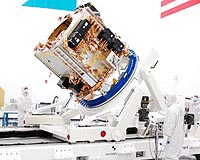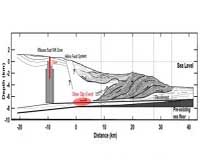| September 04, 2008 |  |
SpaceDaily Advertising Kit |
| Previous Issues | Sep 03 | Sep 02 | Sep 01 | Aug 29 | Aug 28 |
Closest Look Ever At The Edge Of A Black Hole Boston MA (SPX) Sep 04, 2008
Boston MA (SPX) Sep 04, 2008Astronomers have taken the closest look ever at the giant black hole in the center of the Milky Way. By combining telescopes in Hawaii, Arizona, and California, they detected structure at a tiny angular scale of 37 micro-arcseconds - the equivalent of a baseball seen on the surface of the moon, 240,000 miles distant. These observations are among the highest resolution ever done in astronomy. ... more Bringing Satellite Technology Benefits To Regional Populations  Paris, France (ESA) Sep 04, 2008
Paris, France (ESA) Sep 04, 2008The half-day conference "Regional Policy: Benefits from Satellite Information and Services" to be held in Brussels, on the morning of 11th September 2008, is the mid-term event of Eurisy's 5-year programme supporting Local and Regional Authorities to improve their access to the benefits of space technology. Society faces growing challenges while local and regional authorities are increasing ... more Galaxy Zoo An Internet Superstar  Oxford, UK (SPX) Sep 04, 2008
Oxford, UK (SPX) Sep 04, 2008Since Galaxy Zoo's launch in July 2007, some 150,000 members of the public, inspired by the opportunity to be the first to see and classify a galaxy, have helped professional astronomers via this on-line mass-participation project to carry out real scientific research. Two of Galaxy Zoo's founders, Chris Lintott, from the Department of Physics at the University of Oxford, and Kate Land ... more NASA Carl Sagan Fellows To Study Extraterrestrial Worlds  Pasadena CA (SPX) Sep 04, 2008
Pasadena CA (SPX) Sep 04, 2008NASA announced Wednesday the new Carl Sagan Postdoctoral Fellowships in Exoplanet Exploration, created to inspire the next generation of explorers seeking to learn more about planets, and possibly life, around other stars. Planets beyond our solar system, called exoplanets, are being discovered at a staggering pace, with more than 300 currently known. Decades ago, long before any exoplanet ... more Measuring The Winds Of Venus  San Sebastian, Spain (SPX) Sep 04, 2008
San Sebastian, Spain (SPX) Sep 04, 2008Venus is a planet similar in size to the Earth. Nevertheless, it is quite different in other aspects. On the one hand, it spins very slowly on its axis, taking 224 terrestrial days and, moreover, it does so in the opposite direction to that of our planet, i.e. from East to West. Its dense atmosphere of carbon dioxide with surface pressures 90 times that of Earth (equivalent to what we find ... more |
dragonspace:
 eo:  satellite-tech:  |
 Los Angeles CA (SPX) Sep 04, 2008
Los Angeles CA (SPX) Sep 04, 2008Since the Vision for Space Exploration (VSE) was announced in 2004, NASA has been planning to retire the Space Shuttle in 2010. After retirement the U.S. would have no human launch capability until at least 2015. When President Bush announced the VSE, Russian support for continued crew rotation launch services was assumed through the use of the Soyuz spacecraft. Relations between the two ... more Virtual Telescope Zooms In On Super-Massive Black Hole At Heart Of Milky Way  Cambridge MA (SPX) Sep 04, 2008
Cambridge MA (SPX) Sep 04, 2008An international team, led by astronomers at the MIT Haystack Observatory, has obtained the closest views ever of what is believed to be a super-massive black hole at the center of the Milky Way galaxy. The astronomers linked together radio dishes in Hawaii, Arizona and California to create a virtual telescope more than 2,800 miles across that is capable of seeing details more than 1,000 ... more Research Aims To Unmask Comets Posing As Asteroids  Mount Hopkins AZ (SPX) Sep 04, 2008
Mount Hopkins AZ (SPX) Sep 04, 2008Between five and 10 percent of Near Earth Objects could be comets impersonating asteroids, says Paul Abell, who is finding ways to unmask them. NEOs are objects whose orbits bring them in close proximity to Earth. Some NEOs could be dying comets, those that have lost most of the volatile materials that create their characteristic tails. Others could be dormant and might again display comet ... more Billion-dollar European probe set for asteroid encounter  Paris (AFP) Sept 3, 2008
Paris (AFP) Sept 3, 2008Far from Earth, a robot spacecraft has been prodded from deep slumber to make a rare encounter with an asteroid, the intriguing orbital debris that could offer clues into the making of the Solar System. The pride of the European Space Agency (ESA), the probe Rosetta has been ordered out of hibernation four and a half years into a 10-year trek that will take it into the dark chill of deep ... more L-3 Interstate Electronics Introduces New GPS Receivers  Anaheim CA (SPX) Sep 04, 2008
Anaheim CA (SPX) Sep 04, 2008L-3 Interstate Electronics has announced its latest miniaturized GPS receiver. The TruTrak Evolution receiver is a single board L1/L2 24-channel secure GPS receiver that electronically pinpoints exact locations for navigation and tracking purposes. The receiver's advanced technology increases the performance and accuracy of precision guided projectiles, munitions and land attack missiles ... more |
gps:
 gps: gps:  gps:  |
 Saskatoon, Canada (SPX) Sep 04, 2008
Saskatoon, Canada (SPX) Sep 04, 2008Draganfly Innovations has announced the launch of the Draganflyer X6 helicopter, a miniature aircraft for commercial/industrial aerial video and photography. The Draganflyer X6 helicopter is easy to fly, capable of operating autonomously, and has an appearance that is nothing like a conventional helicopter. The unique design utilizes six main horizontal rotor blades and allows the ... more Lockheed Martin Receives Contract For Guided MLRS Unitary Rockets  Dallas, TX (SPX) Sep 04, 2008
Dallas, TX (SPX) Sep 04, 2008Lockheed Martin has received a $61 million follow-on contract for Guided Multiple Launch Rocket System (MLRS) Unitary rockets. To date, more than 850 GMLRS rockets have been fired in the Global War on Terror. Work on the contract will be performed at the company's facilities inCamden, AR, and Dallas, TX. Deliveries will begin in May 2010 and conclude in July of that year. "GMLRS ... more Robotic helicopters teach themselves U.S. scientists say they have created robotic helicopters that can teach themselves to fly by "watching" other helicopters. Stanford University Professor Andrew Ng, who led the project, said the achievement is an important demonstration of "apprenticeship learning," in which robots use an artificial intelligence system to learn by observing an expert, rather than by having software ... more Outside View: BMD dilemmas -- Part Two  Moscow (UPI) Sep 3, 2008
Moscow (UPI) Sep 3, 2008 Russia does not want to be dragged into another arms race, but it should not ignore the emerging threats. The Kremlin's most obvious reply to the U.S. missile defense deployment plans to build a Ground-based Mid-course Interceptor base in Poland would be to equip the Topol-M intercontinental ballistic missiles of Russia's Strategic Missile Force with supersonic maneuverable warheads ... more Outside View: BMD blowback -- Part One  London (UPI) Sep 3, 2008
London (UPI) Sep 3, 2008 The agreement concluded between the United States and Poland on Aug. 20 on the deployment of 10 interceptor missiles, part of America's planned Ballistic Missile Defense system, was an inadvertent -- and possibly unanticipated -- result of the Russian-Georgian conflict. After months of prevarication, the Poles stopped increasing the level of military aid they demanded in return for ... more
|
nuclear-doctrine:
 climate:  hurricane:  earthquake:  |
| Previous Issues | Sep 03 | Sep 02 | Sep 01 | Aug 29 | Aug 28 |
| The contents herein, unless otherwise known to be public domain, are Copyright 1995-2007 - SpaceDaily. AFP and UPI Wire Stories are copyright Agence France-Presse and United Press International. ESA Portal Reports are copyright European Space Agency. All NASA sourced material is public domain. Additional copyrights may apply in whole or part to other bona fide parties. Advertising does not imply endorsement, agreement or approval of any opinions, statements or information provided by SpaceDaily on any web page published or hosted by SpaceDaily. Privacy statement |